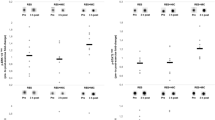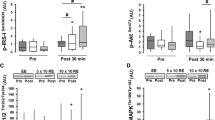Abstract
Purpose
To examine the mitogen-activated protein kinase (MAPK) family of signaling proteins following typical high volume (HV) and high intensity (HI) lower body resistance exercise protocols in resistance-trained men.
Methods
Ten resistance-trained men (24.7 ± 3.4 year; 90.1 ± 11.3 kg; 176.0 ± 4.9 cm) performed each resistance exercise protocol in a random, counterbalanced order. The HV protocol utilized a load of 70 % 1-RM for sets of 10–12 repetitions with a 1-min rest period length between sets and exercises. The HI protocol utilized a load of 90 % 1-RM for sets of 3–5 repetitions with a 3-min rest period length between sets and exercises. Both protocols included six sets of barbell back squats and four sets of bilateral leg press, bilateral hamstring curls, bilateral leg extensions, and seated calf raises. Fine needle muscle biopsies of the vastus lateralis were completed at baseline (BL) and 1-h post exercise (1H).
Results
No significant differences over time were noted for phosphorylation of MEK1, ERK1/2, p38, MSK1, ATF2, p53, or c-Jun (p > 0.05). No significance between trial interactions was noted for phosphorylation of MAPK signaling proteins, including MEK1, ERK1/2, p38, JNK, MSK1, ATF2, STAT1, p53, c-Jun, or HSP27 (p > 0.05). However, significant time effects were observed for phosphorylation of JNK (p < 0.01), HSP27 (p < 0.01), and STAT1 (p = 0.03). Phosphorylation of JNK, HSP27, and STAT1 was significantly elevated from BL at 1H for both HV and HI.
Conclusions
HV and HI lower body resistance exercise protocols appear to elicit similar MAPK activation in resistance-trained men.

Similar content being viewed by others
Abbreviations
- 1-RM:
-
1-repetition maximum
- 1H:
-
1-h post exercise
- ANOVA:
-
Analysis of variance
- ATF2:
-
Activating transcription factor 2
- AU:
-
Arbitrary units
- BL:
-
Baseline
- ERK1/2:
-
Extracellular signal-related kinase 1/2
- HI:
-
High intensity
- HPL:
-
Human Performance Laboratory
- HSP27:
-
Heat shock protein 27
- HV:
-
High volume
- JNK:
-
c-Jun N-terminal kinase
- MAPK:
-
Mitogen-activated protein kinase
- MEK1:
-
Mitogen-activated protein kinase 1
- MSK1:
-
Mitogen- and stress-activated protein kinase 1
- mTORC1:
-
Mammalian target of rapamycin complex 1
- p70S6k:
-
p70S6 kinase
- RPS6:
-
Ribosomal protein S6
- STAT1:
-
Signal transducer and activator of transcription 1
References
Aronson D, Boppart MD, Dufresne SD, Fielding RA, Goodyear LJ (1998) Exercise stimulates c-Jun NH 2 kinase activity and c-Jun transcriptional activity in human skeletal muscle. Biochem Biophys Res Commun 251:106–110
Begue G, Douillard A, Galbes O, Rossano B, Vernus B, Candau R, Py G (2013) Early activation of rat skeletal muscle IL-6/STAT1/STAT3 dependent gene expression in resistance exercise linked to hypertrophy. PLoS One 8:e57141
Boppart MD et al (1999) Eccentric exercise markedly increases c-Jun NH2-terminal kinase activity in human skeletal muscle. J Appl Physiol 87:1668–1673
Brzycki M (1993) Strength testing—predicting a one-rep max from reps-to-fatigue. J Phys Educ Recreat Dance 64:88–90
Damas F, Phillips S, Vechin FC, Ugrinowitsch C (2015) A review of resistance training-induced changes in skeletal muscle protein synthesis and their contribution to hypertrophy. Sports Med 45:801–807
Deldicque L, Atherton P, Patel R, Theisen D, Nielens H, Rennie MJ, Francaux M (2008) Decrease in Akt/PKB signalling in human skeletal muscle by resistance exercise. Eur J Appl Physiol 104:57–65
Drummond MJ et al (2009) Rapamycin administration in humans blocks the contraction-induced increase in skeletal muscle protein synthesis. J Physiol 587:1535–1546
Egan B, Zierath JR (2013) Exercise metabolism and the molecular regulation of skeletal muscle adaptation. Cell Metab 17:162–184
Farooq A, Zhou MM (2004) Structure and regulation of MAPK phosphatases. Cell Signal 16:769–779
Gonzalez AM (2016) Acute anabolic response and muscular adaptation following hypertrophy-style and strength-style resistance exercise. J Strength Cond Res [Epub ahead of print]
Gonzalez AM, Hoffman JR, Stout JR, Fukuda DH, Willoughby DS (2015a) Intramuscular anabolic signaling and endocrine response following resistance exercise: implications for muscle hypertrophy. Sports Med 46:671–685
Gonzalez AM et al (2015b) Intramuscular anabolic signaling and endocrine response following high volume and high intensity resistance exercise protocols in trained men. Physiol Reports 3:e12466
Gonzalez AM et al (2015c) Association between myosin heavy chain protein isoforms and intramuscular anabolic signaling following resistance exercise in trained men. Physiol Reports 3:e12268
Goodman CA (2014) The role of mTORC1 in regulating protein synthesis and skeletal muscle mass in response to various mechanical stimuli. Rev Physiol Biochem Pharmacol 166:43–95
Green S, Salkind N, Akey T (2000) Methods for controlling type I error across multiple hypothesis tests. Using SPSS for Windows Anal Underst Data 2:395–396
Greenhaff PL et al (2008) Disassociation between the effects of amino acids and insulin on signaling, ubiquitin ligases, and protein turnover in human muscle. Am J Physiol Endocrinol Metab 295:E595–E604
Guan KL (1994) The mitogen activated protein kinase signal transduction pathway: from the cell surface to the nucleus. Cell Signal 6:581–589
Haddad F, Adams GR (2004) Inhibition of MAP/ERK kinase prevents IGF-I-induced hypertrophy in rat muscles. J Appl Physiol 96:203–210
Hoffman J (2006) Norms for fitness, performance, and health. Human Kinetics, Champaign
Holm L, van Hall G, Rose AJ, Miller BF, Doessing S, Richter EA, Kjaer M (2010) Contraction intensity and feeding affect collagen and myofibrillar protein synthesis rates differently in human skeletal muscle. Am J Physiol Endocrinol Metab 298:E257–E269
Hulmi J, Walker S, Ahtiainen J, Nyman K, Kraemer W, Häkkinen K (2012) Molecular signaling in muscle is affected by the specificity of resistance exercise protocol. Scand J Med Sci Sports 22:240–248
Hwang J (2011) Using the MILLIPLEX MAP Akt/mTOR 11-plex Panel (Technical Report). EMD Millipore, Billerica, MA
Karlsson HK, Nilsson PA, Nilsson J, Chibalin AV, Zierath JR, Blomstrand E (2004) Branched-chain amino acids increase p70S6k phosphorylation in human skeletal muscle after resistance exercise. Am J Physiol Endocrinol Metab 287:E1–E7
Kumar V et al (2009) Age-related differences in the dose–response relationship of muscle protein synthesis to resistance exercise in young and old men. J Physiol 587:211–217
Landry J, Huot J (1995) Modulation of actin dynamics during stress and physiological stimulation by a signaling pathway involving p38 MAP kinase and heat-shock protein 27. Biochem Cell Biol 73:703–707
McGlory C, Phillips SM (2015) Exercise and the regulation of skeletal muscle hypertrophy. Prog Mol Biol Translational Sci 135:153–173
Mitchell WK, Phillips BE, Williams JP, Rankin D, Lund JN, Smith K, Atherton PJ (2015) A Dose-rather than delivery profile–dependent mechanism regulates the “muscle-full” effect in response to oral essential amino acid intake in young men. J Nutr 114:1–8
Morrison DK (2012) MAP kinase pathways. Cold Spring Harbor Perspect Biol 4:a011254
Nader GA, von Walden F, Liu C, Lindvall J, Gutmann L, Pistilli EE, Gordon PM (2014) Resistance exercise training modulates acute gene expression during human skeletal muscle hypertrophy. J Appl Physiol 116:693–702
Sasai N, Agata N, Inoue-Miyazu M, Kawakami K, Kobayashi K, Sokabe M, Hayakawa K (2010) Involvement of PI3K/Akt/TOR pathway in stretch-induced hypertrophy of myotubes. Muscle Nerve 41:100–106
Sharma N, Castorena CM, Cartee GD (2012a) Tissue-specific responses of IGF-1/insulin and mTOR signaling in calorie restricted rats. PLoS One 7:e38835
Sharma N, Sequea DA, Arias EB, Cartee GD (2012b) Greater insulin-mediated Akt phosphorylation concomitant with heterogeneous effects on phosphorylation of Akt substrates in soleus of calorie-restricted rats. Am J Physiol Regul Integr Comp Physiol 303:R1261–R1267
Shi H, Scheffler JM, Zeng C, Pleitner JM, Hannon KM, Grant AL, Gerrard DE (2009) Mitogen-activated protein kinase signaling is necessary for the maintenance of skeletal muscle mass. Am J Physiol Cell Physiol 296:C1040–C1048
Tannerstedt J, Apró W, Blomstrand E (2009) Maximal lengthening contractions induce different signaling responses in the type I and type II fibers of human skeletal muscle. J Appl Physiol 106:1412–1418
Taylor LW, Wilborn CD, Kreider RB, Willoughby DS (2012) Effects of resistance exercise intensity on extracellular signal-regulated kinase 1/2 mitogen-activated protein kinase activation in men. J Strength Cond Res 26:599–607
Terzis G, Spengos K, Mascher H, Georgiadis G, Manta P, Blomstrand E (2010) The degree of p70S6k and S6 phosphorylation in human skeletal muscle in response to resistance exercise depends on the training volume. Eur J Appl Physiol 110:835–843
Thompson H, Maynard E, Morales E, Scordilis S (2003) Exercise-induced HSP27, HSP70 and MAPK responses in human skeletal muscle. Acta Physiol Scand 178:61–72
Trenerry MK, Della Gatta PA, Larsen AE, Garnham AP, Cameron-Smith D (2011) Impact of resistance exercise training on interleukin-6 and JAK/STAT in young men. Muscle Nerve 43:385–392
Widegren U, Ryder J, Zierath J (2001) Mitogen-activated protein kinase signal transduction in skeletal muscle: effects of exercise and muscle contraction. Acta Physiol Scand 172:227–238
Williamson D, Gallagher P, Harber M, Hollon C, Trappe S (2003) Mitogen-activated protein kinase (MAPK) pathway activation: effects of age and acute exercise on human skeletal muscle. J Physiol 547:977–987
You JS, Frey JW, Hornberger TA (2012) Mechanical stimulation induces mTOR signaling via an ERK-independent mechanism: implications for a direct activation of mTOR by phosphatidic acid. PLoS One 7:e47258
Author information
Authors and Affiliations
Corresponding author
Additional information
Communicated by William J. Kraemer.
Rights and permissions
About this article
Cite this article
Gonzalez, A.M., Hoffman, J.R., Townsend, J.R. et al. Intramuscular MAPK signaling following high volume and high intensity resistance exercise protocols in trained men. Eur J Appl Physiol 116, 1663–1670 (2016). https://doi.org/10.1007/s00421-016-3417-8
Received:
Accepted:
Published:
Issue Date:
DOI: https://doi.org/10.1007/s00421-016-3417-8




